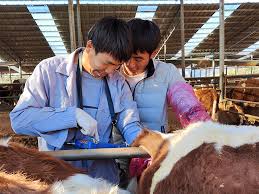Among the texture feature extraction methods of animal liver veterinary B-ultrasound images, the statistical method is widely used in traditional veterinary B-ultrasound machines, that is, texture is regarded as a random statistical process, and texture is defined by some statistical features abstracted from local areas.
Grayscale co-occurrence matrix method, the joint probability distribution of two grayscale pixel pairs (d, 0) in veterinary B-ultrasound images (d is the distance between the two pixels, 0 is the angle between the line connecting the two and the horizontal direction) can be represented by a grayscale co-occurrence matrix, and a series of texture measurements can be defined after normalization of this matrix. Commonly used texture feature parameters of animal liver veterinary B-ultrasound images mainly include physical quantities such as energy, entropy, contrast and inverse difference. Since the grayscale co-occurrence matrix method comprehensively reflects the grayscale statistical information and spatial information of veterinary B-ultrasound images, it is not affected by grayscale intensity within a certain limit, and can extract rotation-independent features. Therefore, it has been widely used in the texture feature extraction of veterinary B-ultrasound images of various diffuse animal liver diseases.

Although some measures obtained by the gray-level co-occurrence matrix method can sensitively reflect the changes in texture density and shape characteristics of animal liver veterinary B-ultrasound images, there are also some disadvantages: dependence on direction θ will ignore the relative directionality and lead to the loss of some texture information, and it is easy to be disturbed by noise; in addition, it is expensive to calculate different d,0 in the calculation method. For this reason, some people have made some improvements to the gray-level co-occurrence matrix method. First, the gray-level image is converted into a feature image using the veterinary B-ultrasound image feature encoding method, so that each pixel corresponds to a texture feature number, and then the co-occurrence matrix of TFN is calculated, and further texture parameters that better distinguish normal, hepatitis and cirrhosis are obtained.








